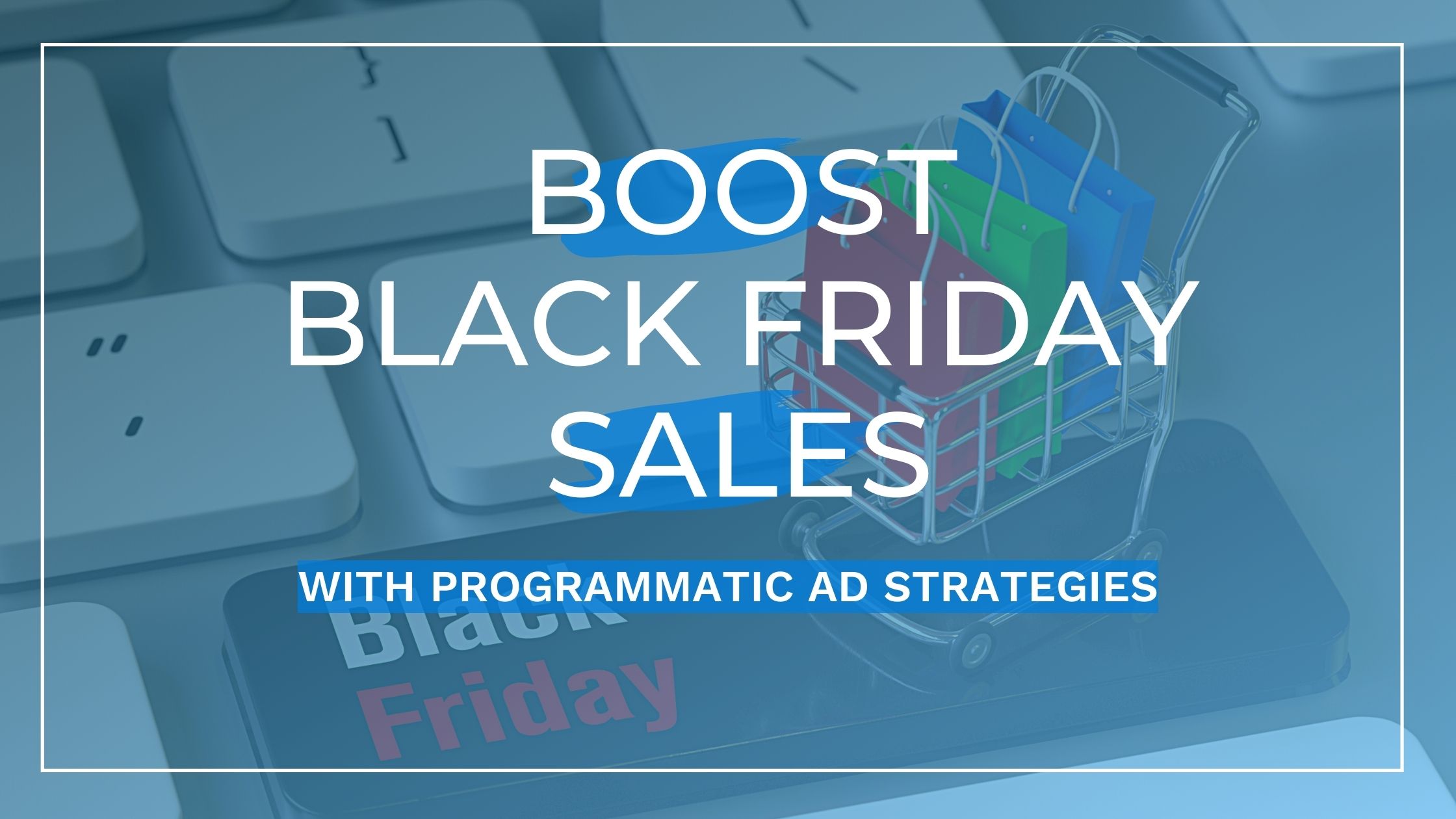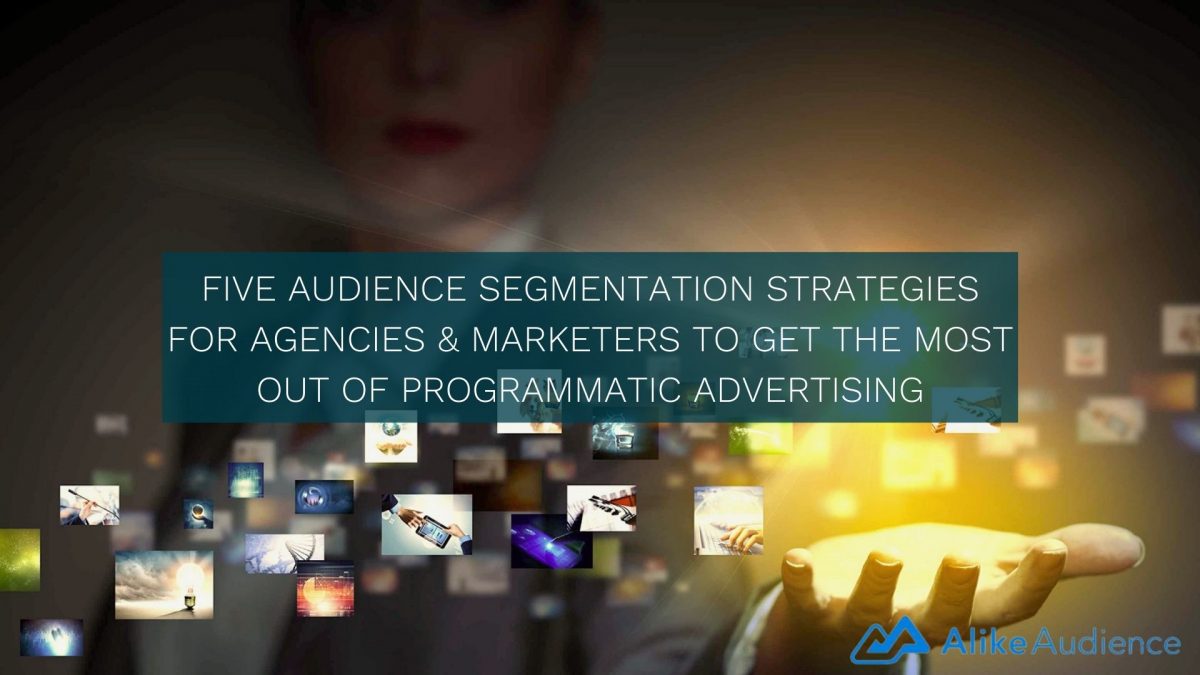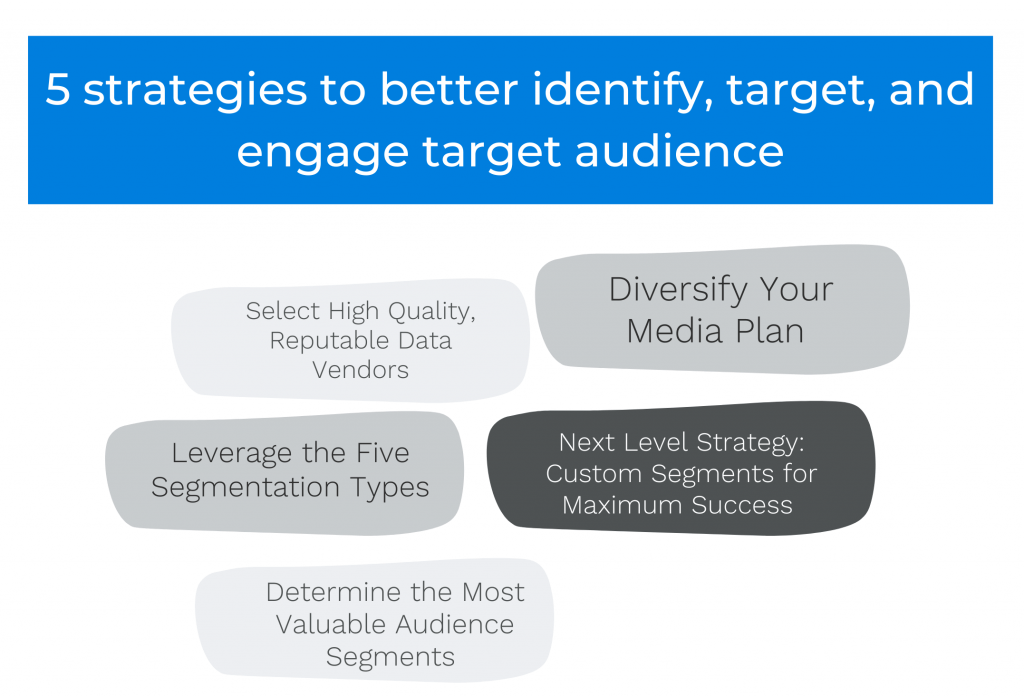
Boost Black Friday Sales with Programmatic Ad Strategies
October 21, 2021
The Power of Psychographic Segmentation
December 5, 2021
A comprehensive guide to audience segmentation for media buyers, agency planners, and marketers bidding on programmatic advertising on Demand-Side Platforms (DSPs).
Contents
- What is Audience Segmentation?
- Market Segmentation vs. Audience Segmentation
- The Five Audience Segmentation Strategies for Success
3.1 Select High Quality, Reputable Data Vendors
3.2 Leverage the Five Segmentation Types
3.3 Determine the Most Valuable Audience Segments
3.4 Diversify Your Media Plan
3.5 Next Level Strategy: Custom Segments for Maximum Success - Conclusion
- References & Further Reading
What is Audience Segmentation?
Audience segmentation uses big data collected from mobile devices, desktops, and transaction data to divide audiences based on gender, age, location, interests, behavior, and other characteristics. Audience segmentation helps marketers tailor their offers, products, and services to the best prospects for better engagement and successful conversion.
While market segmentation is used by marketers to group their audiences, audience segmentation involves target audiences which can be activated in ad campaigns via digital ad tech tools and media platforms.
Read also: Why Demographic Segmentation Should Be Your Go-to Audience Segmentation Tactic for Ad Campaigns
Introduction
In an era of media fragmentation and changing consumer behaviors, marketers today face ever-growing challenges when it comes to uncovering and targeting key audiences for successful campaigns in programmatic advertising.
Audience segmentation is no longer a matter of simply targeting audiences on media platforms: agency planners and marketers have to remember that the “where,” “when,” and “how” are just as important as the “who.”
Today’s consumers are expecting more personalization than ever that is relevant to their own interests, making effective online advertising more complex, especially when compounded by concerns over personal privacy. Yet, there are also more opportunities today with consumers spending an average of almost 7 hours a day on their devices, many of those on social media.
In this guide, AlikeAudience identifies five strategies for marketers and agencies to better identify, target, and engage their target audience based on industry best practices to achieve high ROI campaigns with minimum ad spend wastage.
Related: How an eCommerce Brand Increases Return on Advertising Spend by 300%

Read on to learn more about each strategy.
Strategy #1: Select High Quality Data Vendors: What to Consider
Although programmatic platforms like The Trade Desk and LiveRamp have made it easy to advertise to your desired target audience on diverse digital channels, the large number of data vendors on marketplaces can make it difficult to access data quality when all the audience segments on offer seem to be similar.
The truth is that the quality of data vendors can vary widely and that to navigate the landscape of good vs. bad vendors, you need experience and methodology to determine the highest sources of inventory and data.
When selecting data vendors, these are some factors marketers and agencies should consider:

- SCALE: How many people will the audience segment reach? Although scale is an attractive factor, marketers should consider that the bigger the scale, the less accurate the target audience.
- ACCURACY: Research shows that much of the audience segments available on programmatic media buying platforms is unreliable and conflicting, with as much as 84% misattribution for demographic traits such as age and gender. To evaluate accuracy, look into the data provider’s methodologies or check your data vendor’s Nielsen ratings or comScores.
- QUALITY: The more thorough and the higher the quality of your consumer data, the more effective your consumer segments. High quality sources of data include mobile data—which is exponentially more accurate than desktop cookies—and transaction data—the most accurate predictor of purchase intent.
- COST: In our survey of U.S. marketers and agencies, pricing is the second most important factor after considering audience reach. Whatever your marketing budget, your advertising spend should generate maximum returns by purchasing segments that have the lowest Cost-Per-Mile (CPM).
- PRIVACY: For brand safety, this is one of the most important considerations when selecting data vendors. Ensure that your data vendor is fully compliant with industry standards such as GDPR and CCPA as well as commit to high privacy standards with integrity.
- PRECISION: Depending on how well you understand your best performing customers, evaluate whether your target segments are concisely articulated. For example, if you are targeting a “hip mom” demographic, you can also find connections such as their 12-year old game enthusiast sons and SUV-loving husbands to incorporate precise subcategories that take into account the latest research. Read more about demographic segmentation here.
- DATA SOURCE: Evaluate where your data vendor obtained their audience segment data. The closer your vendor is to the original data source and working with consumer consented CRM data, the higher the performance of your campaign. AlikeAudience is not a data aggregator, nor use recycled data. Our direct data sources provides high scale, fresh, and relevant audiences with flexible lookback windows.
AlikeAudience tackles each of these considerations head-on by offering data at scale (reaching 70% of mobile devices in the U.S. alone) and providing high-performing, third-party mobile and transaction that are tested to be up to 90% accurate for age and gender by Nielsen—all at the best value compared to other data vendors. Our audience segments are also 100% device agnostic and are CTV-ready.
Learn more about how we can help you deliver high-performing connected TV ad campaigns here. Or contact our data strategist for more information.

Privacy is also one of AlikeAudience’s most important values and how we built the company. Our business is based on privacy models to prepare for the future of Big Data. We work only with trusted data partners and consumer-consented data that are fully compliant with GDPR and CCPA regulations. As a member of the IAB Tech Lab and Network Advertisting Initative, AlikeAudience is uncompromising in our standards and processes to protect consumer privacy.
After selecting a high-quality vendor, it’s time to understand the pros and cons of different segment types.
Strategy #2: Leverage the Five Types of Segmentation for Success
It’s important for marketers to understand the different types of segmentation and how they vary to identify which type would best suit your business. To help you decide, weigh the pros and cons of these five types of segmentation. We recommend using a combination of attributes to succeed in audience targeting.
1. DEMOGRAPHIC SEGMENTATION
Demographics describe the general attributes of a person such as age, gender or ethinicity. AlikeAudience’s OTP segments have been tested to be up to 90% accurate for Age & Gender by Neilsen Digital Ad Ratings.

AlikeAudience’s most popular demographic segments include segments by ethnicity (size 39.8 mn) and by life stages (size 50.5mn).
Read also: Why Demographic Segmentation Should Be Your Go-to Audience Segmentation Tactic for Ad Campaigns
2. BEHAVIORAL SEGMENTATION
Behavioral segments tell you the actions consumers take. This could be their online shopping habits, or whether they identify as “baby boomers” or “Generation Z”.

AlikeAudience’s most popular behavioral segments include online casino gamblers (size 16.7 mn) and audiences who order food delivery (size 14.6mn).
Read also: Use Behavioral Segmentation to Boost Your Programmatic Ad Campaign
3. GEOGRAPHIC SEGMENTATION
These explain where your target market is located. This can be as expansive or narrow as you like, from continent to zip code.

4. PSYCHOGRAPHIC SEGMENTATION
These give you clues into their wider perceptions, interests and mindsets. For example, why they like or dislike certain brands, why they enjoy certain movie genres, their lifestyle choices or values.

AlikeAudience’s most popular psychographic segments include value conscious shoppers (size: 58.3mn) and online streaming enthusiasts (size: 50.3mn).
Read also: The Power of Psychographic Segmentation
5. TRANSACTIONAL (CREDIT CARD) SEGMENTATION
These are segments compiled from actual credit card data to segment customers based on actual purchase histories.

AlikeAudience’s most popular transactional segments include affluent shoppers, broadway ticket buyers, and other types of high-end spenders.
With 7,000+ segments to choose globally, AlikeAudience matches exclusive credit card data with mobile signals such as location data to offer marketers industry-leading, privacy-compliant audience solutions. Find all five segmentation types by AlikeAudience on major DSPs and partner marketplaces for your campaign today by searching “AlikeAudience.”
Through a deeper understanding of segment types, we can now determine how to leverage an effective audience targeting strategy using a few principles for segmentation.
Strategy #3: Determine the Most Valuable Audience Segments

- Establish goals before defining audience segments: Rather than focusing solely on attributes, it is important to look at your audience’s motivations. For example, gamers who are looking for cheat codes may ignore ads that offer product sales ads and be more interested in topical branded information.
- Use detailed customer personas: The more detailed your persona, the clearer the picture of who the target audience is. Start with your audience’s core set of demographics such as age, location and ethnicity. Add a combination of attributes--including behavioral, regional, and psychographic--to reveal the big picture.
- Find out what works for different audiences: To increase reach, marketers need to be clear on what engages their customer segments and how their behaviors differ across channels. The key to successful campaigns is to find out what works for different audiences. For example, statistics show that when targeting mothers, incentives like free delivery and discounts are the most effective purchase drivers.
When it comes to audience segmentation strategies, details matter. Without enough detail, marketers run the risk of becoming too broad in their targeting and turning potential customers away. When you take the time to segment your audience with the most up-to-date, in-depth data, you can enjoy greater profit margins and more engaged customers.
Once you have determined your high-value audience segmentation and targeting strategy, it’s time to co-ordinate your media plan.
Strategy #4: Diversify Your Media Plan for Full Spectrum Reach
Marketers run into three issues when investing their advertising budget to media: reach, frequency, and wastage. To tackle these challenges, marketers and agencies can consider focusing on diversifying and coordinating their media plan. According to Garner research, marketers are more likely to boost audience reach by diversifying campaigns across media, such as integrating TV with digital campaigns, rather than keeping campaigns siloed. To do this, marketers can:

By coordinating advertising across a full spectrum of channels with high-quality customer data, marketers can connect with high-value audiences everywhere they engage with content.
Strategy #5: Next Level Strategy: Custom Segments for Maximum Success
In a perfect world, you’d be able to gather enough detail from your segmentation to reach every individual with a completely bespoke, personalized campaign. Although this isn’t possible (yet), there’s a way around many of the common challenges people face with segmentations.
While off-shelf marketplace segments from third-party data gives you the ability to build out fundamental segments for your business, to go deeper and get more specific to your niche audiences or categories, custom data is what’s needed.
Benefits of Custom Audience Solutions:

Whether you are a CPG brand looking to target specialized shoppers by past purchases, or hyper target any niche attributes such as professional, AlikeAudience can help you reach the perfect customer for optimal campaign results. Brands and marketers can select from 5 Attribute Categories including: demographic, psychographic, geographical, behavioral, and transaction to create specific customer profiles delivered via any DSP within days.
Click here for a case study on how custom segments can help marketers get maximum ROAS on their campaigns.
Summary
We’ve covered in depth a variety of audience segmentation strategies for agencies and marketers to execute campaigns with programmatic advertising on DSPs. With today’s competitive AdTech landscape, it is important to select high-quality data vendors with scale, accuracy, quality, and trusted data sources, choose the right audience segment types, create detailed customer personas, and diversify your media plan.
For some marketers, leveraging custom segments can propel your campaign to success by executing a completely bespoke, personalized campaign. When marketers and agencies take into account all of these factors, you can ensure your campaign will be successful for maximum return on your advertising spend and in reducing ad wastage.
References:
